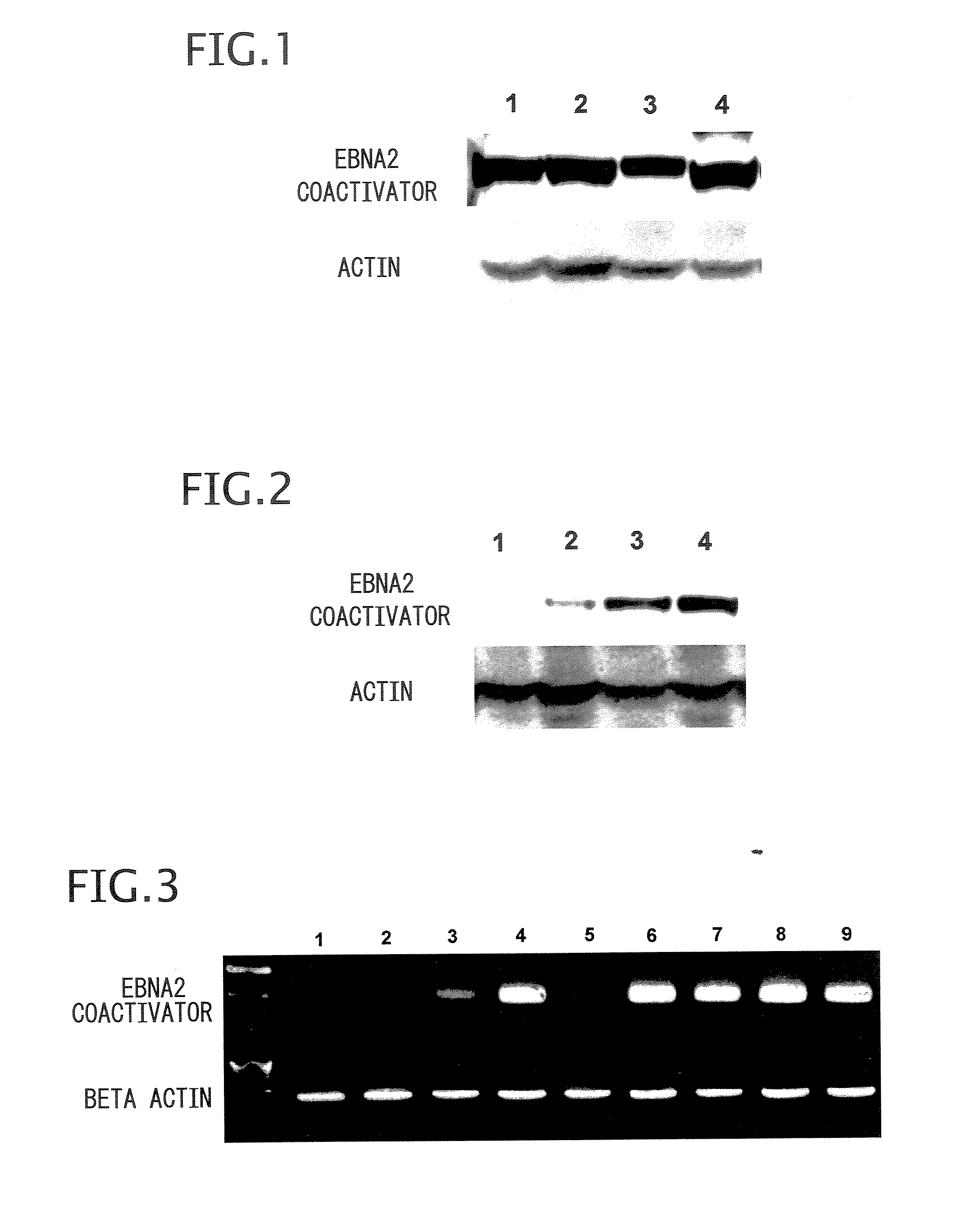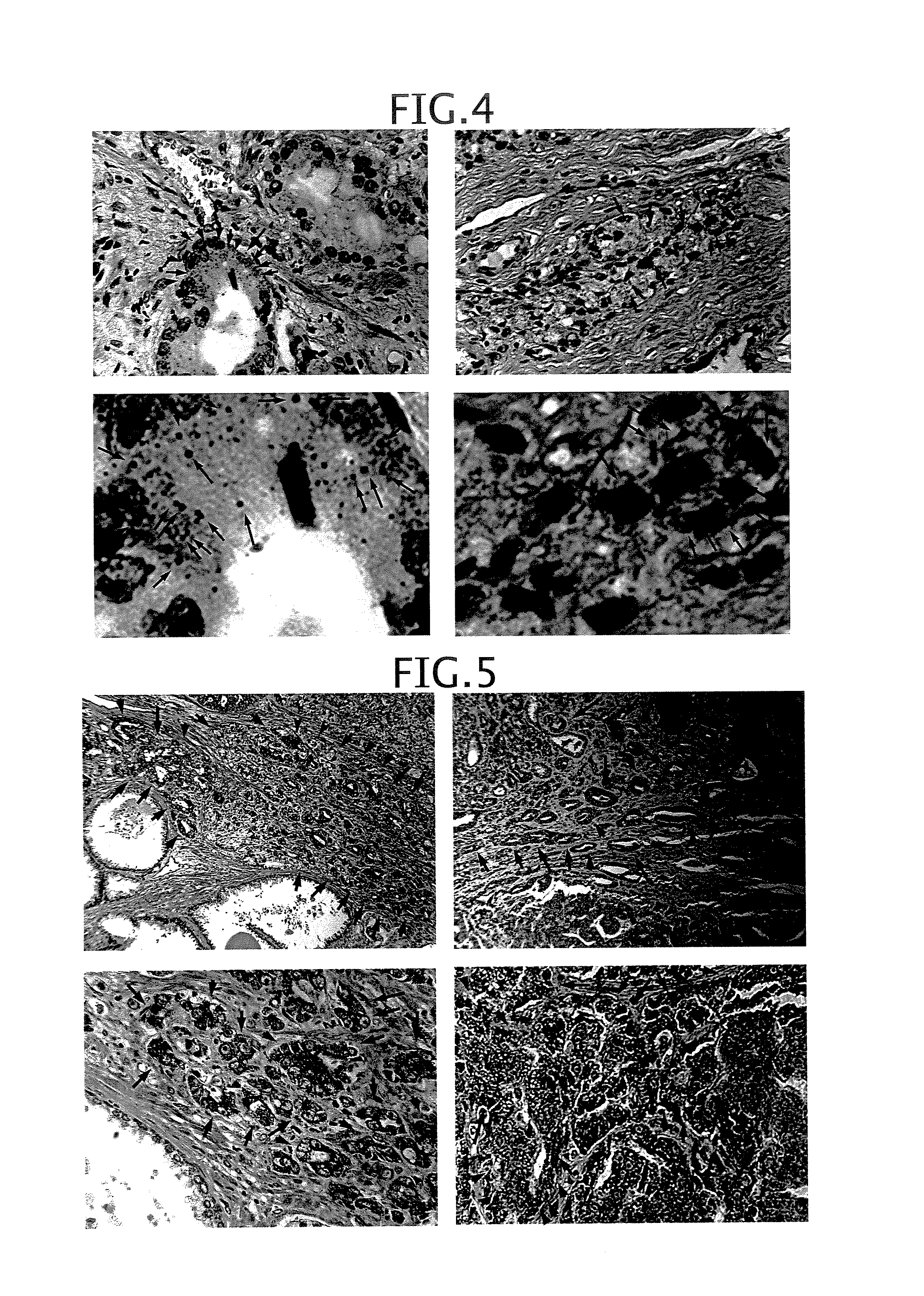Method and composition for detecting cancer by means of detection of epstein-barr virus nuclear antigen 2 coactivator p100
- Summary
- Abstract
- Description
- Claims
- Application Information
AI Technical Summary
Problems solved by technology
Method used
Image
Examples
example 1
Preparation of EBNA2 Coactivator p100 Antibody
[0064] A peptide of EBNA2 coactivator p100 amino acid sequence 423 to 400 (RPASPATETVPAFSERTC) (SEQ ID NO. 1) was synthesized and bound with maleimide-activated KHL using a cysteine residue for use as an immunogen followed by subcutaneously inoculating into a rabbit with adjuvant eight times at two week intervals. After collecting whole serum, the titer of the target antibody in the antiserum was confirmed as the reactive titer with antigen peptide by enzyme-linked immunosorbent assay (ELISA). In order to purify the target antibody from the antiserum, the antiserum was precipitated and concentrated with 50% saturated ammonium sulfate followed by recovery of the IgG fraction with a protein G-immobilized column. Moreover, the target antibody was purified and acquired by affinity purification with a column immobilized with antigen peptide, and the resulting target antibody was used in the following experiments.
example 2
Detection of Antigen in a Cancer Cell Lines by Western Blotting Analysis Using Anti-EBNA2 Coactivator Antibody
[0065] Androgen-dependent and non-androgen-dependent prostate cancer cells were prepared for use as cancer cell lines. Commercially available LNCaP cell line (American Type Culture Collection (ATCC), Rockville, Md., USA) were used as androgen-dependent human prostate cancer cells, and said LNCaP cell line was maintained and cultured in culture medium containing 10% fetal bovine serum (e.g., Roswell Park Memorial Institute (RPMI) medium) followed by mixing 1×107 of the cultured LNCaP cells with 0.1 mL of Matrigel (Becton Dickinson Labware, N.J., USA). The cells were subcutaneously inoculated into male nude mice (BALB / c strain) and the testes were excised when the resulting tumor reached 100 to 200 mm3. Although the tumor temporarily reduced in size, it soon began to grow again. Tumors prior to testectomy at this time were used as androgen-dependent prostate cancer, while tum...
example 3
Detection of Antigen in Human Prostate Tissue By Western Blotting Using Anti-EBNA2 Coactivator Antibody
[0067] Normal human prostate tissue and prostate cancer tissue were obtained from excised specimens from patients who underwent surgery. These specimens were mainly obtained from patients who underwent surgery in the department of urology of the Kitazato University Hospital located in Sagamihara City, Kanagawa Prefecture, Japan after having obtained their consent. Using two specimens or normal tissue and two specimens of prostate cancer tissue, detection was carried out in the same manner as Example 2 by Western blotting using anti-EBNA2 coactivator polyclonal antibody. Those results are shown in FIG. 2. An increased in the expressed amount was observed in the prostate cancer tissue as compared with the normal tissue.
[0068] The results of carrying out detection with anti-EBNA2 coactivator polyclonal antibody are shown in the top of FIG. 2 using normal tissue in lanes 1 and 2 and ...
PUM
 Login to View More
Login to View More Abstract
Description
Claims
Application Information
 Login to View More
Login to View More - R&D
- Intellectual Property
- Life Sciences
- Materials
- Tech Scout
- Unparalleled Data Quality
- Higher Quality Content
- 60% Fewer Hallucinations
Browse by: Latest US Patents, China's latest patents, Technical Efficacy Thesaurus, Application Domain, Technology Topic, Popular Technical Reports.
© 2025 PatSnap. All rights reserved.Legal|Privacy policy|Modern Slavery Act Transparency Statement|Sitemap|About US| Contact US: help@patsnap.com



